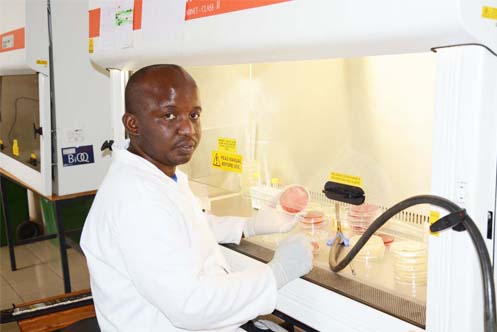
UR and Partners launch innovative research project to tackle urban mobility challenges in Africa
- 16-04-2025
- 1499

Jean Baptiste Ndahetuye
Thousands and thousands of people consume milk every day. Cows producing such milk can contract different dis¬eases that threaten the supply of milk. One of the most common diseases in dairy cows is mastitis, which is an inflam¬mation of the mammary gland that is caused mainly by dif¬ferent bacteria. Mastitis negatively affects milk yield and milk quality in dairy cows. Bacteria causing mastitis could be from environment around the cow, from other cows with infection in the udder or from human during milking. If precautions are not taken, dairy cows could suffer from mastitis for a long time and this will compromise their welfare and milk yield.
This thesis was undertaken to better understand mastitis and milk quality in Rwanda. Dairy cows have a great cultural and economic importance in Rwanda, where most of the milk is produced by small holder farmers. Milk has been recognized to be important for the nutritional status of young children and for their growth and cognitive development. The cattle population and milk production is increasing, partly due to national pro¬grams striving for enhanced human nutritional status and food security and safety. Mastitis can be either clinical with obvious changes in the udder and milk or subclinical without visible signs.The research focused on subclinical mastitis as it is more prevalent and it often goes undetected in the herd and affects milk yield and quality. Ndahetuye screened 828 cows in 429 herds from five regions in Rwanda with a cow-side test named california mastitis tests and taken milk samples from affected udder quarters for analysis of which bacteria cause the mastitis.
In addition, he studied antibiotic resistance in the isolated mastitis-causing bacteria. Furthermore, he studied how milk quality and safety is affected by different practices at farm. Results showed that subclinical mastitis prev¬alence was around 70% on herd level, 65% on cow level and 40% on quarter level. That means around 6 cows out of 10 have inflam¬mation in at least one of the udder quarters. About 75% of cultured milk samples in all regions were bacteriologically positive and 25% were bacteriologically negative. In all regions, staphylococci (non-aureus staph¬ylococci (NAS) followed by Staphylococcus (S.) aureus) were the predominant bacteri¬al pathogens causing subclinical mastitis.
In conclusion, subclinical mastitis is common in dairy herds in Rwanda and the majority of causative udder pathogens are resistant to penicillin. Contamination of milk in the production chain leads to a high microbial load in milk which is of importance for milk quality, processability and public health.
Molecular characterization of S. aureus showed that this pathogen is highly di¬verse in subclinical mastitis cases in Rwan¬da, which provide knowledge on biosecuri¬ty, how mastitis is spread and how to best implement preventive measures. An overall mastitis control plan is recommended in or¬der to optimize milk production in Rwanda.
Jean Baptiste Ndahetuye is currently a Lec¬turer at the University of Rwanda, College of Agriculture, Animal Sciences and Veterinary Medicine in the School of Animal Sciences and Veterinary Medicine.He recently ob¬tained his PhD from the Swedish University of Agricultural Sciences, in the Department of Clinical Sciences and his research focused on Mastitis in dairy cows in Rwanda : Char¬acterization, Prevalence, etiology, molecular epidemiology and effects on milk quality. The overarching goal with this research is to increase milk production, quality and safety from farm to milk collection centers (MCC) level in Rwanda.